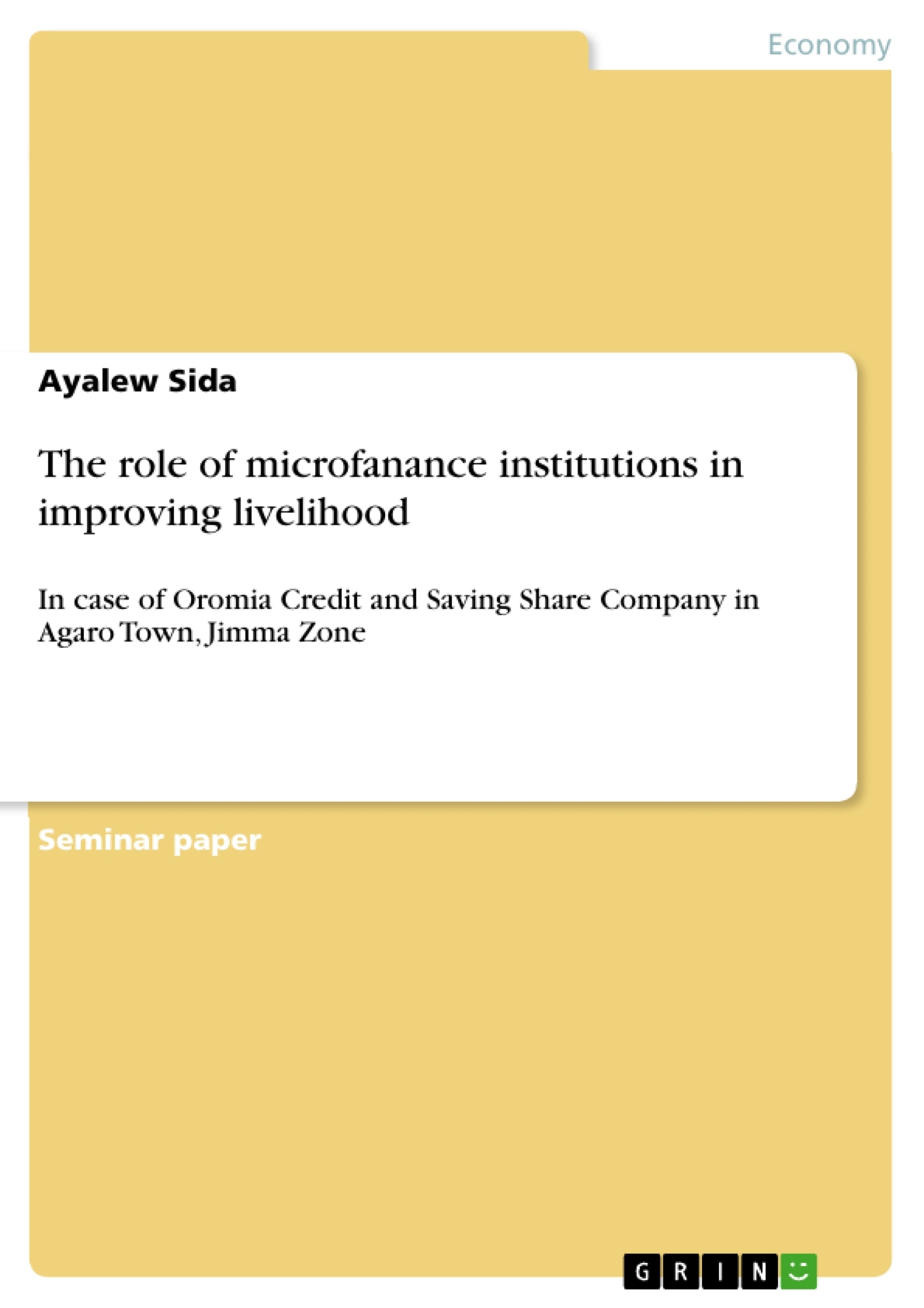Livelihoods are ‘means of making a living’, the various activities and resources that allow people to live. It comprises the capabilities, assets (including both material and social) and activities required for a means of living. Thus, microfinance programs have been considered as one of the main instruments in livelihood improvement in recent development agenda. Microfinance comprises the provision of financial services including credit and other facilities like savings, insurance, and transfer services to poor household. The study was conducted in Geniji-Dalecho and Bulbulo kebeles among 35 target kebeles of the OCSSCO. The main objective of the study is to identify the contribution of OCSSCO in improving household livelihood through providing credit. Further, the study used both primary and secondary data sources. The primary data was collected with semi-structured interview and focus group discussion from sampled respondents; whereas, secondary data gathered from different documents of the microfinance institution that exists in the study area. Stratified random sampling was used to select 60 respondents (35 beneficiaries and 25 non-beneficiaries) based on the principle of probability proportional to size (pps). Generally, Microfinance Institutions have an explicit potential that intends to improve the livelihoods of households. While improving livelihood, microfinance (OCSSCO) credit service increases the income of the clients; which, in turn, enable them educating their children and improves their nutritional status. Inferential statistics such as crosstabs; independent sample t-test and custom table are used in data analysis. Descriptive statistics like frequency, percentage, mean and standard deviation were employed to analyze the data. Chi-square (for categorical variables) and t-test (for continuous variables) were used to see the significance of the relationships of independent variables with dependent variables. Moreover, the qualitative data was analyzed by describing, summarizing and interpreting for further clarity. Finally, conclusion and recommendation were made based on the findings obtained from result and discussion.
Key words: assets, client, role, microfinance institution, livelihood,
Inhaltsverzeichnis (Table of Contents)
- 1. INTRODUCTION
- 1.1. Background
- 1.2. Problem statement
- 1.3. Objective of the Study
- 1.3.1. General objective
- 1.3.2. Specific objectives
- 1.4. Research Questions
- 1.5. Significance of the Study
- 1.6. Scope and Limitation of the Study
- 1.6.1. Scope of the study
- 1.6.2. Limitation of the study
- 1.7. Conceptual Framework
- 2. LITERATURE REVIEW
- 2.1. Theoretical Literature Review
- 2.1.1. Definitions and concepts
- 2.1.2. Sustainable livelihood framework
- 2.2. Empirical Review
- 2.2.1. Microfinance and its role in economic development
- 2.2.2. The role of microfinance on poverty reduction
- 2.2.3. Role of microfinance on livelihoods
- 2.3. Null Hypothesis
- 2.1. Theoretical Literature Review
- 3. METHODOLOGY
- 3.1. Description of the Study Area
- 3.2. Type of Research Design
- 3.3. Data Sources and Types
- 3.4. Method of Data Collection
- 3.5. Sampling Techniques and sample size
- 3.6. Methods of Data Analysis
- 3.6.1. Econometric Method of data analysis
- 4. RESULT AND DISCUSSION
- 4.1. Demographic Characteristics of Sample Respondents
- 4.1.1. Sex sample respondents
- 4.1.2. Religion and Marital Status of Sample Households
- 4.1.3. Age, family size and age composition of sample households
- 4.1.4. Educational Status of Sample Household Heads
- 4.2. Major Sources of Household Income
- 4.3. Loan Purpose and Income Generating Activities of the Households
- 4.4. Household Income and Expenditure
- 4.5. Challenges of the Households in Credit Participation
- 4.5.1. Challenges related to transportation
- 4.5.2. Challenges related to the size of the loan and repayment time (due time)
- 4.6 Child Education and the Microfinance Services
- 4.6.1 Children Access to Education
- 4.6.2. Expenditure on Education
- 4.7. Logistic Regression
- 4.1. Demographic Characteristics of Sample Respondents
- 5..CONCLUSION AND RECOMMENDATIONS
- 5.1. Conclusion
- 5.2. Recommendations
Zielsetzung und Themenschwerpunkte (Objectives and Key Themes)
This research paper aims to investigate the role of microfinance institutions in improving livelihoods, specifically focusing on the case of the OCSSCO in Agaro Town, Jimma Zone, Ethiopia. The study seeks to understand the impact of microfinance services on household income, expenditure, and educational opportunities.
- Impact of microfinance on household income and expenditure
- Role of microfinance in promoting income-generating activities
- Relationship between microfinance access and educational attainment
- Challenges faced by households in accessing and utilizing microfinance services
- Contribution of microfinance institutions to sustainable livelihood development
Zusammenfassung der Kapitel (Chapter Summaries)
The research paper begins by introducing the background, problem statement, objectives, research questions, and significance of the study. It provides a conceptual framework for understanding the role of microfinance institutions in improving livelihoods.
Chapter 2 delves into a comprehensive literature review, exploring theoretical concepts related to microfinance and sustainable livelihoods. It examines empirical studies on the role of microfinance in poverty reduction and improving livelihoods. The chapter concludes by stating the null hypothesis of the study.
Chapter 3 outlines the methodology used in the research. It describes the study area, research design, data sources, and methods of data collection and analysis. The chapter provides details on the sampling techniques and sample size, highlighting the specific methodology used for analyzing the collected data.
Chapter 4 presents the results and discussion of the study, focusing on the demographic characteristics of the sample respondents, their income sources, loan purposes, income-generating activities, household income and expenditure, challenges in accessing microfinance, and the impact of microfinance on child education.
Schlüsselwörter (Keywords)
The key terms and concepts explored in this research paper include microfinance institutions, livelihoods, poverty reduction, income-generating activities, household income and expenditure, access to education, sustainable development, and econometric analysis.
- Quote paper
- Ayalew Sida (Author), 2013, The role of microfanance institutions in improving livelihood, Munich, GRIN Verlag, https://www.grin.com/document/278538



